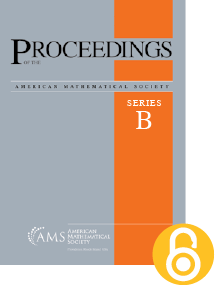On the sharpness of the bound for the Local Converse Theorem of $p$-adic ${\operatorname {GL}}_{prime}$
HTML articles powered by AMS MathViewer
- by Moshe Adrian, Baiying Liu, Shaun Stevens and Geo Kam-Fai Tam HTML | PDF
- Proc. Amer. Math. Soc. Ser. B 5 (2018), 6-17
Abstract:
We introduce a novel ultrametric on the set of equivalence classes of cuspidal irreducible representations of a general linear group ${\operatorname {GL}}_{N}$ over a non-archimedean local field, based on distinguishability by twisted gamma factors. In the case that $N$ is prime and the residual characteristic is greater than or equal to $\left \lfloor \frac {N}{2}\right \rfloor$, we prove that, for any natural number $i\le \left \lfloor \frac {N}{2}\right \rfloor$, there are pairs of cuspidal irreducible representations whose logarithmic distance in this ultrametric is precisely $-i$. This implies that, under the same conditions on $N$, the bound $\left \lfloor \frac {N}{2}\right \rfloor$ in the Local Converse Theorem for $\operatorname {GL}_N$ is sharp.References
- Moshe Adrian and Baiying Liu, Some results on simple supercuspidal representations of $\mathrm {GL}_n(F)$, J. Number Theory 160 (2016), 117–147. MR 3425202, DOI 10.1016/j.jnt.2015.08.002
- Moshe Adrian, Baiying Liu, Shaun Stevens, and Peng Xu, On the Jacquet conjecture on the local converse problem for $p$-adic $\mathrm {GL}_N$, Represent. Theory 20 (2016), 1–13. MR 3452696, DOI 10.1090/ert/476
- Colin J. Bushnell and Guy Henniart, The essentially tame local Langlands correspondence. I, J. Amer. Math. Soc. 18 (2005), no. 3, 685–710. MR 2138141, DOI 10.1090/S0894-0347-05-00487-X
- Colin J. Bushnell and Guy Henniart, The local Langlands conjecture for $\rm GL(2)$, Grundlehren der mathematischen Wissenschaften [Fundamental Principles of Mathematical Sciences], vol. 335, Springer-Verlag, Berlin, 2006. MR 2234120, DOI 10.1007/3-540-31511-X
- Colin J. Bushnell and Guy Henniart, The essentially tame local Langlands correspondence, III: the general case, Proc. Lond. Math. Soc. (3) 101 (2010), no. 2, 497–553. MR 2679700, DOI 10.1112/plms/pdp053
- Colin J. Bushnell and Guy Henniart, Langlands parameters for epipelagic representations of $\textrm {GL}_n$, Math. Ann. 358 (2014), no. 1-2, 433–463. MR 3158004, DOI 10.1007/s00208-013-0962-x
- Colin J. Bushnell and Guy Henniart, Higher ramification and the local Langlands correspondence, Ann. of Math. (2) 185 (2017), no. 3, 919–955. MR 3664814, DOI 10.4007/annals.2017.185.3.5
- Jingsong Chai, Bessel functions and local converse conjecture of Jacquet, 2016, J. Eur. Math. Soc., to appear.
- Jiang-Ping Chen, Local factors, central characters, and representations of the general linear group over non-Archimedean local fields, ProQuest LLC, Ann Arbor, MI, 1996. Thesis (Ph.D.)–Yale University. MR 2694515
- Jiang-Ping Jeff Chen, The $n\times (n-2)$ local converse theorem for $\textrm {GL}(n)$ over a $p$-adic field, J. Number Theory 120 (2006), no. 2, 193–205. MR 2257542, DOI 10.1016/j.jnt.2005.12.001
- J. W. Cogdell and I. I. Piatetski-Shapiro, Converse theorems for $\textrm {GL}_n$. II, J. Reine Angew. Math. 507 (1999), 165–188. MR 1670207, DOI 10.1515/crll.1999.507.165
- Helmut Hasse, Number theory, Grundlehren der Mathematischen Wissenschaften [Fundamental Principles of Mathematical Sciences], vol. 229, Springer-Verlag, Berlin-New York, 1980. Translated from the third German edition and with a preface by Horst Günter Zimmer. MR 562104, DOI 10.1007/978-3-642-66671-1
- Guy Henniart, Caractérisation de la correspondance de Langlands locale par les facteurs $\epsilon$ de paires, Invent. Math. 113 (1993), no. 2, 339–350 (French, with English and French summaries). MR 1228128, DOI 10.1007/BF01244309
- Roger E. Howe, Tamely ramified supercuspidal representations of $\textrm {Gl}_{n}$, Pacific J. Math. 73 (1977), no. 2, 437–460. MR 492087, DOI 10.2140/pjm.1977.73.437
- Herve Jacquet and Baiying Liu, On the local converse theorem for p-adic gln, 2016, Amer. J. Math., to appear.
- Dihua Jiang, Chufeng Nien, and Shaun Stevens, Towards the Jacquet conjecture on the local converse problem for $p$-adic $\textrm {GL}_n$, J. Eur. Math. Soc. (JEMS) 17 (2015), no. 4, 991–1007. MR 3349305, DOI 10.4171/JEMS/524
- H. Jacquet, I. I. Piatetskii-Shapiro, and J. A. Shalika, Rankin-Selberg convolutions, Amer. J. Math. 105 (1983), no. 2, 367–464. MR 701565, DOI 10.2307/2374264
- Allen Moy, Local constants and the tame Langlands correspondence, Amer. J. Math. 108 (1986), no. 4, 863–930. MR 853218, DOI 10.2307/2374518
- Freydoon Shahidi, Fourier transforms of intertwining operators and Plancherel measures for $\textrm {GL}(n)$, Amer. J. Math. 106 (1984), no. 1, 67–111. MR 729755, DOI 10.2307/2374430
Additional Information
- Moshe Adrian
- Affiliation: Department of Mathematics, Queens College, CUNY, Queens, New York 11367-1597
- MR Author ID: 846441
- Email: moshe.adrian@qc.cuny.edu
- Baiying Liu
- Affiliation: Department of Mathematics, Purdue University, 150 N. University Street, West Lafayette, Indiana, 47907
- MR Author ID: 953254
- Email: liu2053@purdue.edu
- Shaun Stevens
- Affiliation: School of Mathematics, University of East Anglia, Norwich Research Park, Norwich, NR4 7TJ, United Kingdom
- MR Author ID: 678092
- Email: Shaun.Stevens@uea.ac.uk
- Geo Kam-Fai Tam
- Affiliation: Max Planck Institute for Mathematics, Vivatsgasse 7, 53111 Bonn, Germany
- Email: geotam@mpim-bonn.mpg.de
- Received by editor(s): January 12, 2017
- Published electronically: February 20, 2018
- Additional Notes: The first author was supported by a grant from the Simons Foundation (#422638) and by a PSC-CUNY award, jointly funded by the Professional Staff Congress and The City University of New York.
The second author was supported in part by the National Science Foundation under agreements number DMS-1128155, DMS-1620329, and DMS-1702218, and in part by a start-up fund from the Department of Mathematics, Purdue University.
The third author was supported by the Engineering and Physical Sciences Research Council (grant EP/H00534X/1).
The fourth author was supported by postdoc funding from McMaster University and the University of Calgary.
Any opinions, findings, and conclusions or recommendations expressed in this material are those of the authors and do not necessarily reflect the views of the National Science Foundation. - Communicated by: Matthew A. Papanikolas
- © Copyright 2018 by the authors under Creative Commons Attribution 3.0 License (CC BY 3.0)
- Journal: Proc. Amer. Math. Soc. Ser. B 5 (2018), 6-17
- MSC (2010): Primary 11S70, 22E50; Secondary 11F85, 22E55
- DOI: https://doi.org/10.1090/bproc/32
- MathSciNet review: 3765745


